How to make self-raising flour from plain (or all-purpose) flour and baking powder.
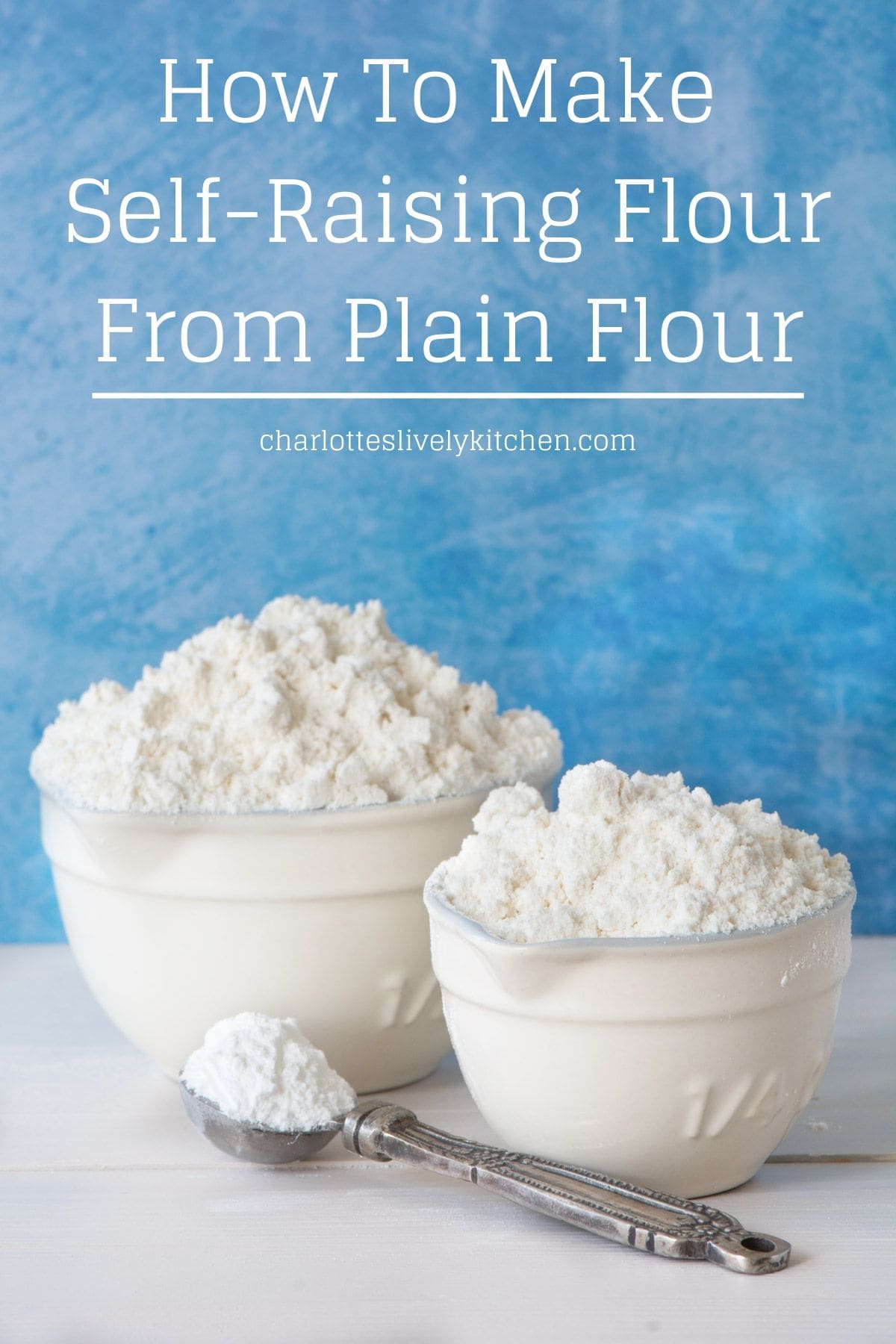
I use self-raising flour in a lot in my recipes and one question I get asked quite regularly is how they can be adapted to be made from plain or all-purpose flour with added baking powder.
There are lots websites and books about which suggest the correct quantity of baking powder to add to plain to turn it into self-raising, but annoyingly they don’t all agree.
Nigella suggests adding ½ tsp of baking powder and ½ tsp of bicarbonate of soda to 150g of plain flour, whereas Baking Mad suggests adding 2 tsp of baking powder to 150g of flour. Then King Arthur Flour proposes adding 1½ tsp of baking powder and ¼ tsp of salt to 120g of flour. As you can see the suggestions aren’t even close!
So how how on earth do we know how much baking powder is needed to make self-raising flour?
My solution (the same as always)… to get into the kitchen and get baking.
The experiment
I decided to make lots of simple vanilla cupcakes, one batch using self-raising flour and then all the others made with plain flour and subtly different amounts of baking powder.
NOTE – The vanilla cupcake recipe I used for these experiments is ever so slightly different from the recipe linked above, as in that recipe I add extra baking powder. For this experiment I decided to leave that out as I felt it gave a cleaner comparison.
The results
As expected, the more baking powder that’s used the greater the rise.

You can see the cupcake made with just plain flour is much shorter than the others. Also, as it baked a lot of the fat bubbled out leaving it dry and dense. If you ever have a cake that doesn’t rise as expected, it would suggest that your baking powder isn’t working properly (or you’ve use bicarbonate of soda instead – something I’ll be writing a post about soon).
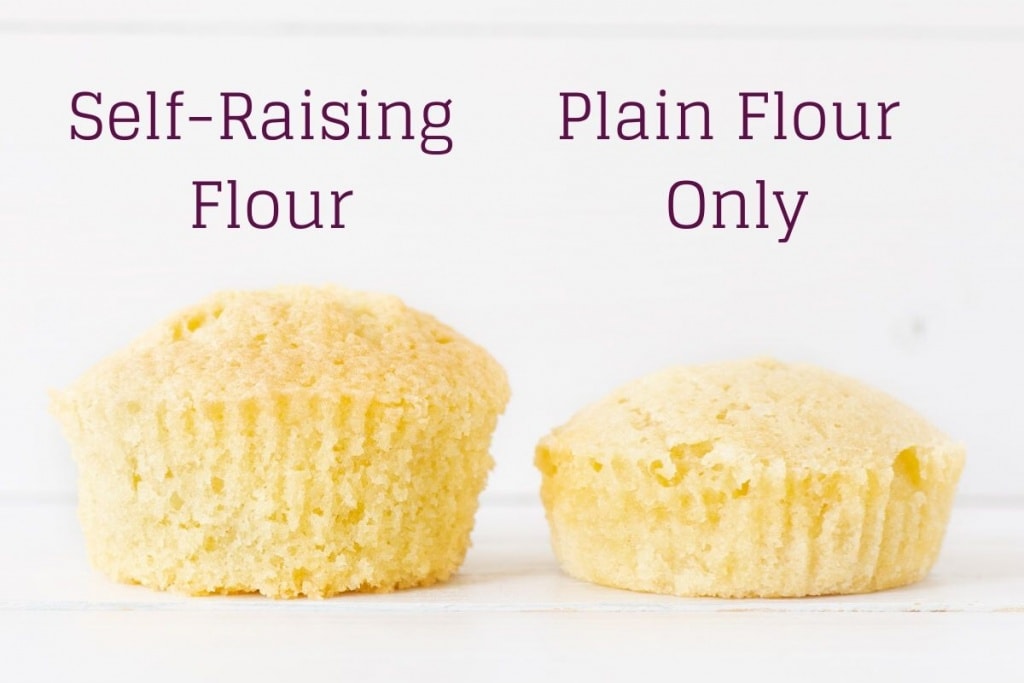
If you want to check your baking powder you can add a little to some boiling water. If it bubbles (the bubbling will be quite furious), you can get baking. If not, it’s time to get to the shops for a fresh packet.
Going to the other end of the scale, when you compare the cupcake made with self-raising flour to the cupcake made with 1 tsp of baking powder per 50g of plain flour, you can see that the plain flour cupcake is taller (especially at the sides) and flatter on top. I like a tall flat cupcake which is why I often add additional baking powder to my recipes when using self-raising flour.
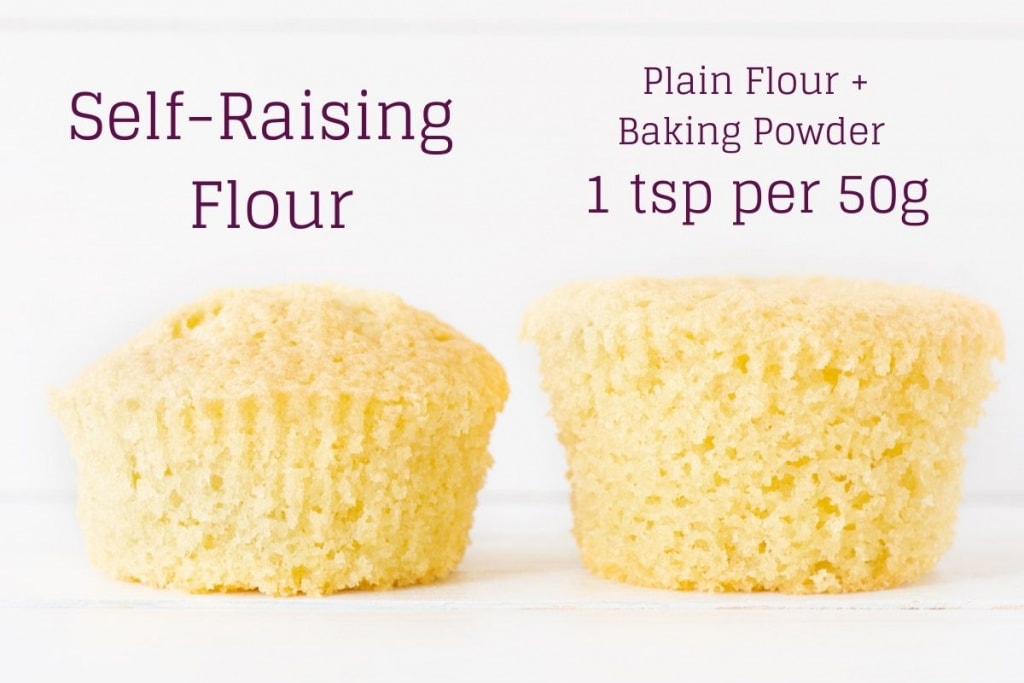
So, much like in goldilocks and the three bears we have one cupcake that’s too small and one cupcake that’s too big and fluffy. All we need now is a cupcake that’s just right…
How much baking powder should be added to plain flour to make self-raising flour?
The answer is 1 tsp of baking powder per 100g of plain flour.
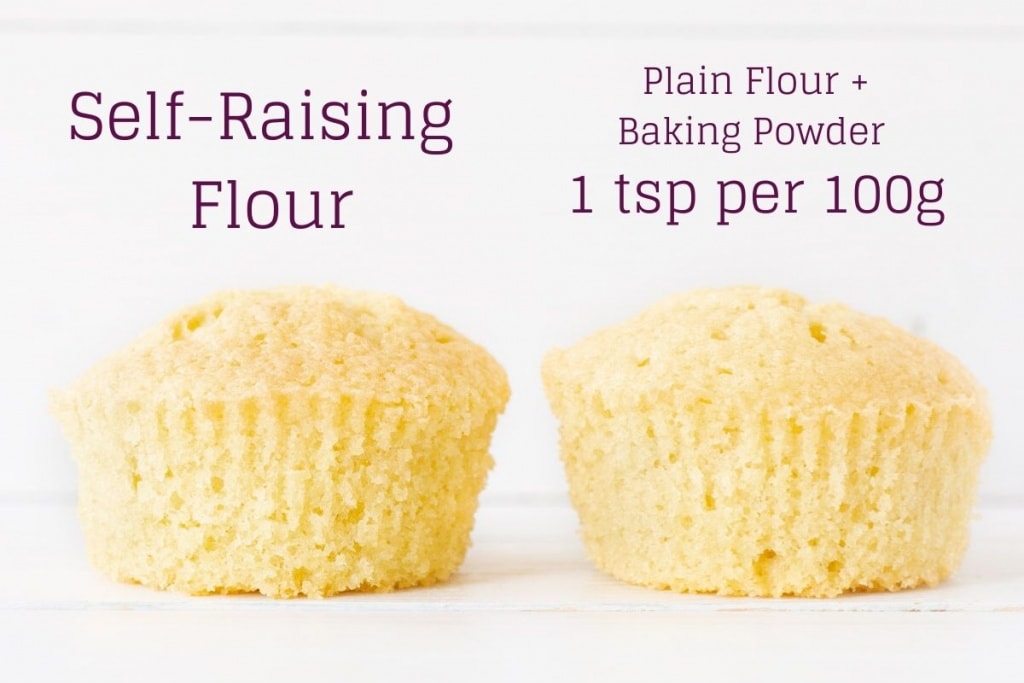
You can see that the cupcakes are not only nearly identical in terms of height, they’ve also got a very similar dome on top.
Is that a heaped teaspoon or a level teaspoon?
Always a level teaspoon (much more accurate as some teaspoons will hold a bigger heap than others depending on their shape).
Also, I always use a measuring teaspoon rather than one I’d use to make a cup of tea as again it’s much more accurate.
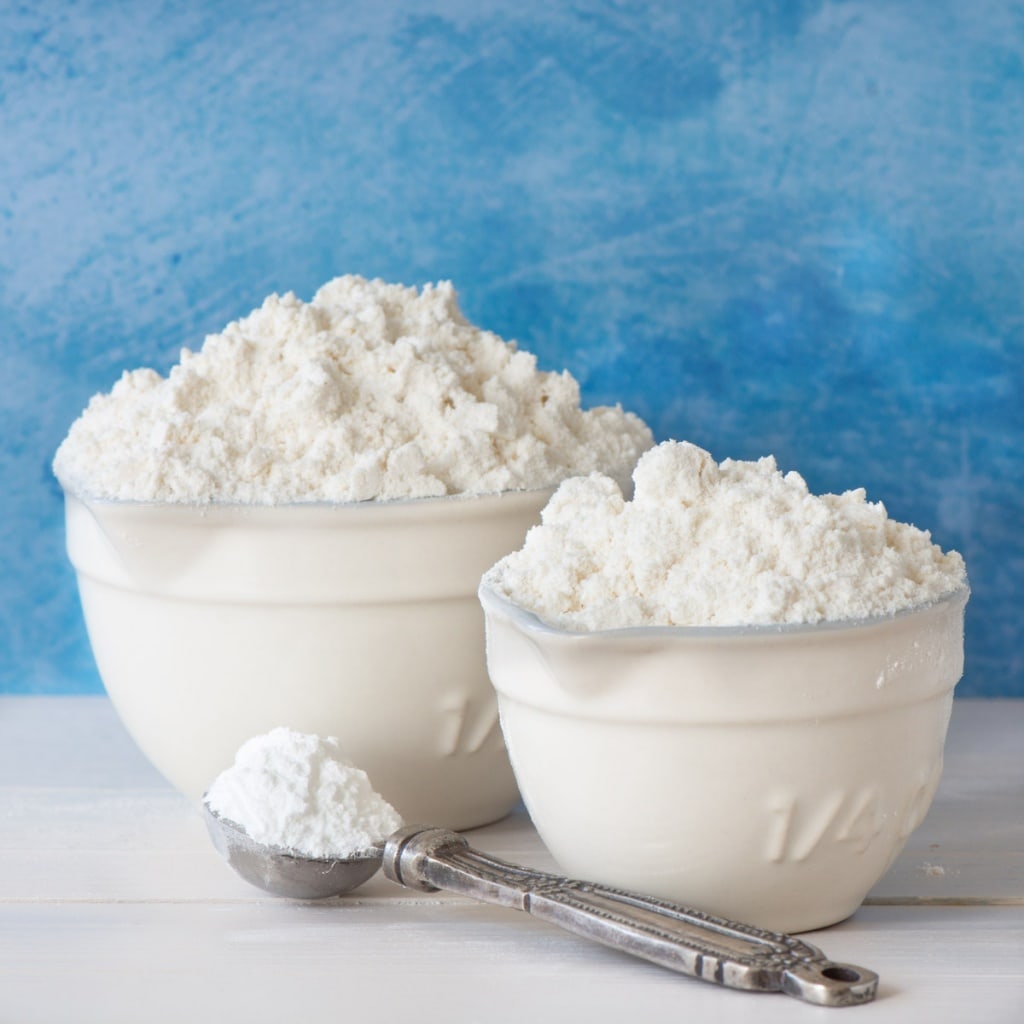
Is self-raising flour in the UK the same as self-rising flour in the US?
Unfortunately not, so if you find a recipe that calls for one of these and you’re not in the right country then I’d suggest using a homemade version.
The version I’ve shared here is for UK self-raising flour (as that’s what I use and what I can get hold of in the shops for my testing). US self-rising flour has a lower amount of baking powder and also contains added salt.
FREE GRAMS TO CUPS CONVERSION CHARTS
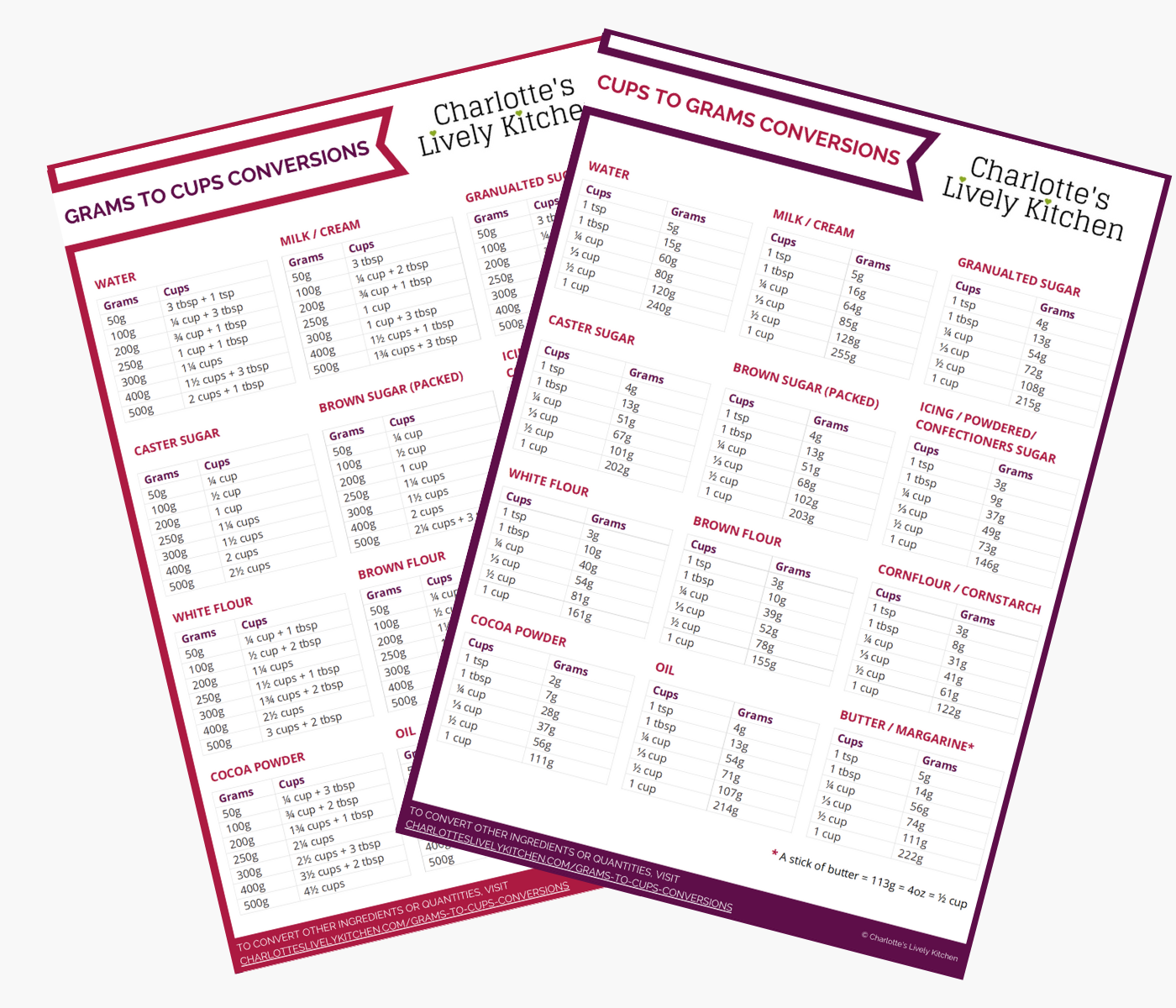
Subscribe to the Charlotte’s Lively Kitchen mailing list to get your FREE printable grams to cups and cups to grams conversion charts for twelve popular baking ingredients
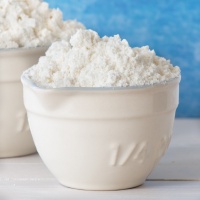
How To Make Self-Raising Flour
INGREDIENTS
- 100 g plain or all-purpose flour
- 1 level tsp baking powder - I always use a measuring teaspoon rather than one I'd use to make a cup of tea as it's much more accurate.
INSTRUCTIONS
- Put your ingredients (100g plain flour, 1 tsp baking powder) into a large bowl.
- Mix together (I like to use a whisk) until the baking powder is evenly distributed in the flour.
- Your self-raising flour is now ready to use in your chosen recipe.
NOTES
NUTRITIONAL INFORMATION
Any nutritional information provided is the estimated nutritional information per serving. Please refer to my guide to Charlotte’s Lively Kitchen nutritional information if you would like to learn more about how this is calculated.


Vibeke says
Thank you for taking the time to test this, and share it here! great to know how much baking powder to use, and loved seeing the results in pictures 😀
Stephen Daniels says
Remember if you are in the US, a US tsp. is smaller than an imperial (UK) tsp. (of course it is I hear you cry!). I believe Charlotte is using UK tsp. measurements so you will need just a little bit more baking powder state-side.
1 US tsp. = 4.93 ml
1 UK tsp. = 5.92 ml
Charlotte Oates says
I use a measuring tsp which is 5ml. Most of the ones you can buy in the UK seem to be.
Nihil says
The business.
So tired of folks filling their recipe information with personal blah as if it’s entertainment but then the recipes are dodgy or the measurements unclear and it takes forever to find the recipe amongst the novel.
But here we have the bees knees and the dogs bollards, so to speak.
Thanks for getting down to business and clearing this up. Nothing but information with energy resolving edge case questions and real world dilemmas. How refreshingly useful!
The only improvement would be to also specify cups / teaspoons (as opposed to grams) for those of us that are, for some inexplicable reasons, managing multiple kids, a full time job, unprovoked communist-state legal attacks and a hobby in home baking without an actual scales to measure ingredients with. I saw your cups – grams conversion tables (more kudos for that) and used them, but it could be a little more convenient to get a tailored set of measurements, within the recipe, so we can use our intuition and judgement instead of a measuring stick 😉
Anna says
Worked perfectly! Thanks so much for taking the time to experiment and get the quantities right.
LT says
I’m in Canada but have a lot of UK cookbooks picked up on visits and I was never sure how much extra baking powder to add to replicate self-rising flour. This is so helpful–thank you!!
Jennifer says
So helpful! I have researched this before and come away confused. As a US baker who sometimes uses recipes from the UK, you have resolved my question about making my own self-raising flour according to UK standards so my baking turns out right. Thanks for doing these experiments and sharing what you learned in an easy-to-understand way. My family will thank you when they eat their “gooseberry gems” tonight!
בוורלי יעקבסון says
So helpful. After reading so much information I was more confused than knowledgable. Thanks for doing all the leggwork for us!
Paul says
Thanks! both for doing the experimentation and the final info! This will really help w/ the odd recipe that calls for it.
Ro says
Agree this is helpful, thanks. But I would expect to use more baking powder in a recipe for scones or similar and a ‘normal’ amount, which you have demonstrated so well in sponge cake but probably less in a fruit cake.
Charlotte Oates says
I’m trying to replicate the self-raising flour sold in the UK. Quite often recipes will call for extra baking powder if needed.
Carol Clark says
For those of us who are not UK residents, what is the equivalent of 100g of flour in cups? Thank You!
Charlotte Oates says
I have a grams to cups conversations calculator that you can use to work this out.
Grams to Cups / Cups to Grams Conversions Calculator
Vicki says
Thank you Charlotte for sharing the results of your experiments – very helpful :).
;
s
Annette Davis says
Wonderful especially as she did experiments
Martin says
What about different brands of self raising flour? Are they all the same? Surely the amount of raising agent will be different when comparing shipton mills self raising flour compared to a more mainstream brand.
This could explain why different cookbooks have different suggestions. How do you take that variability into account?
Charlotte Oates says
I haven’t taken that variability into account as very few cookbooks, unless they’re published by a specific brand, specify which brand of self-raising flour to use. Each brand doesn’t publish the amount of raising agent they use so I cannot comment on whether the do vary significantly. However, I’d be very surprised if there is a huge variation. Brands want to provide a product that works. They know that most recipes will just call for self-raising flour. If they include a different amount to most other brands, then recipes will regularly fail using their product and people will stop buying it.
What I did was test against a popular brand of flour and so I get the same results I would expect many others to get. I’ve also used several different brands over the years and not had noticeable variations in rise with the different kinds.
Marion says
I am curious, is the flour used in self-rising flour in the UK same as in US? In the US it is a soft wheat flour which means less protein and thus less gluten than the hard wheat which is generally used in All-Purpose flours in the US. This means too that self-rising is a wee bit closer to cake flour. Bread flour has even more protein and thus more gluten than A-P flour does. S-R will therefore make better American style biscuits than A-P flour does- lighter and fluffier inside. I appreciate your notes as I am converting a UK recipe for US products, and your article is a big help. Thank you.
Charlotte Oates says
I’m afraid that I have not used the US flours so I’m not in a position to properly advise on the differences and similarities.
Maggie says
I really appreciate your explaining the difference between UK and US self-raising flour! I was following a UK recipe but had to make my own flour and really messed it up so the scones tasted horrible. Trying again with your flour, fingers crossed!
Yoshita dhillon says
What about where recipe asks for self raising flour plus baking powder for example 275 gm of self raising flour and 2 tsp of baking powder?
If I am using plain flour then should I add 1.5 tsp of baking powder or 3.5 tsp?
Charlotte Oates says
3.5
Tricia Groen says
What about bicarb of soda + plain flour?
Charlotte Oates says
This is actually something I’m planning to write about soon. At the moment I’d only recommend using baking powder until I’ve finished my experiments and I can tell you the best way to use bicarbonate of soda.
Akita says
Finally, some scientific methods in the recipe-section of the internet, thank you!
Marios Pseftoudis says
We can’t get self raising flour in Switzerland well I’ve not seen it in super. So this is very helpful.
Thank you
Borisimo says
Awesome! Thank you for this, so so useful! Real lifesaver and a good visual guide.